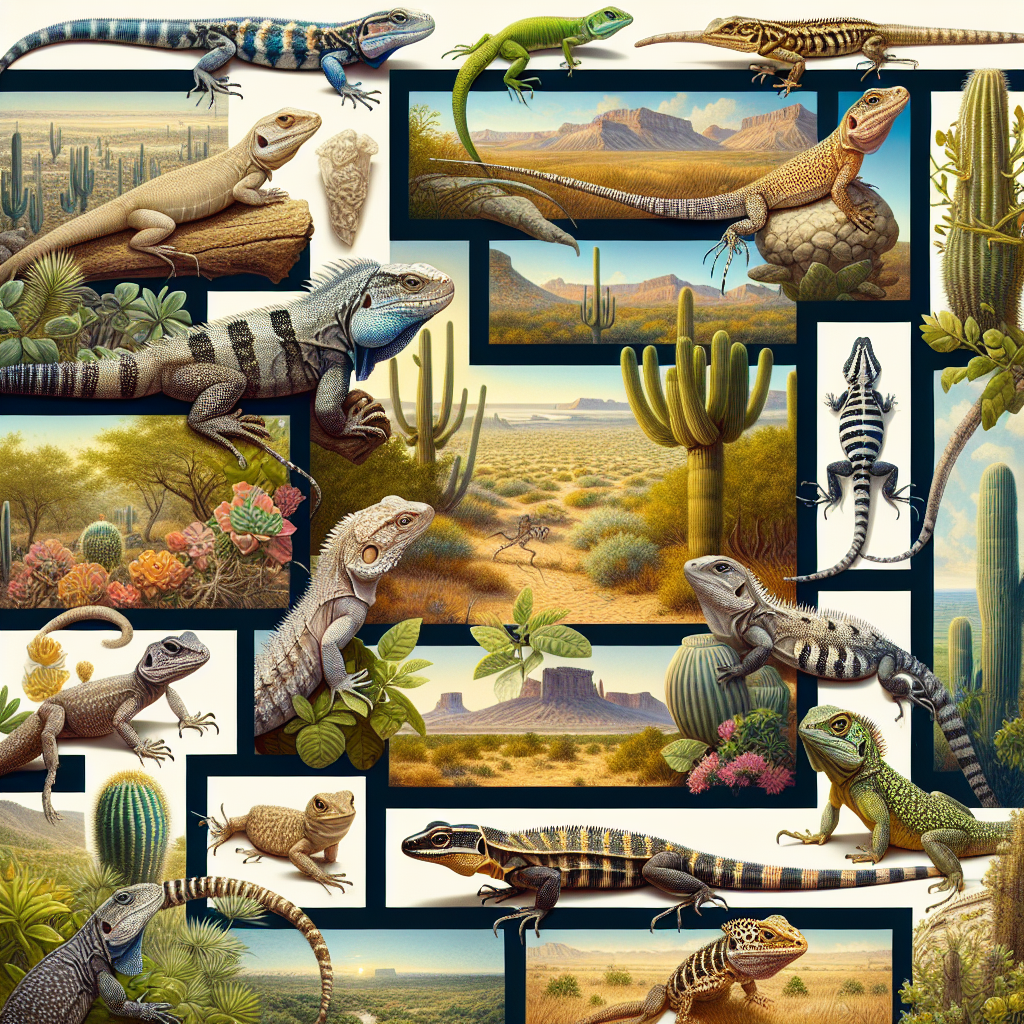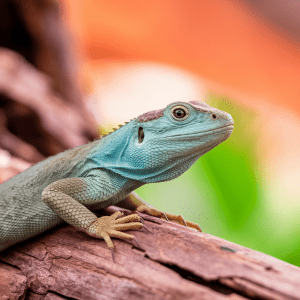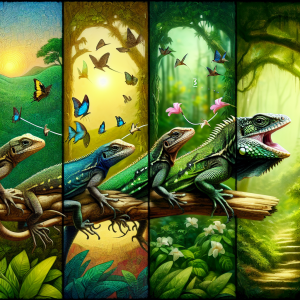Howdy, adventurous families! Ever stumbled upon a tiny, scaly creature while hiking and wondered, "What kind of lizard is that?" Fear not! Our "North American Lizard Identification Guide" has got you covered. We understand that making sense of our scaly friends can be like cracking a reptilian code. With an astonishing 300 or so species just in North America, figuring out if you're looking at a Texas Horned Lizard or a North American Green Anole can feel more like a laborious task than fun family learning.
Well, breathe a tiny sigh of relief. Because this comprehensive guide could be your Rosetta Stone for everything lizard-related! Yes, you read it right, we’ve assembled facts and tips for understanding and identifying these delightful cold-blooded friends.
Think of it more as an exciting exploration ranging from the common characteristics and families of lizards, to their varied habitats, and even a sneak peek into their quirky behaviors and lifespans. Yep, we're taking a deep dive into the mystical world of lizards, bringing their fascinating realm closer to yours.
Heads up folks! You'll be impressing each other—and probably a few curious onlookers—with your newfound lizard lore knowledge sooner than you might think. Ready to join us on this intriguing journey? Here we go!
Understanding North American Lizard Species
Remember those glorious summer days when taking the kids exploring through the wilderness was your favorite pastime? Ever stumbled upon a reptile, shimmering in the sun, slithering through the undergrowth? Chances are, you were looking at one of North America's varied lizard species.
Understanding North American lizard species doesn’t require you to be a naturalist or a scientist, it simply demands a spark of inquisitive joy and little bit of patience. That's where our North American Lizard Identification Guide becomes a crucial tool in your adventure. Our guide eases your challenges by taking each piece of the identification puzzle and placing it right in the palm of your hand – figuratively, of course; we advise against handing actual lizards.
Firstly, we invite you to consider the lizard's habitat. We're not talking about specific GPS coordinates, just general scenery. Are you by a stream, out in the desert, or are you exploring a leafy woodland? Not all lizard species share the same zip code.
Knowing their habitat not only leads to identifying lizards faster, but also encourages an appreciation for nature's spaces and habitats. For instance, a Five-Lined Skink elegantly patterned with bright stripes may pop up near wood, whereas you might spot a Fringe-toed Lizard amidst sand dunes. Fascinating, right?
Open your minds to the world of diverse lizard species and let curiosity steer your journey. With our North American Lizard Identification guide, every family excursion could turn into an epic educational experience – and maybe even include some charming lizard photo opportunities. Ready to become brave reptile explorers? Stay tuned for the next section to know more!
Identifying Common Characteristics in Lizards

Ever found yourself on a family camping trip, stumbling across a conspicuous little creature scuttling through your RV kitchen? One of the wonderful plusses of family journeying through nature's playground are the memorable moments and learning surprises, like identifying lizards. Let's start with unmasking common lizard features with our ever-handy North American Lizard Identification Guide.
Oblong-shaped bodies and an extended tail give lizards a silhouette that's unmistakably theirs. Another fundamental characteristic is brilliantly-hued or camouflaged dry, scaly skin that fits like a well-loved maps puzzle. When you come across a curious critter, ask yourself: Does it have four legs, two eyes, and pair of ear holes? Congrats, you've found a reptile – possibly one you can ID thanks to our guide!
Remember, the search for these characteristics may require patience, as lizards are small, swift, and rather sneaky. We can hear the question, 'how the heck do I spot ear holes?' Unlike us, their ‘ears’ are just tiny openings, often hidden. Have your binoculars handy!
Our North American Lizard Identification Guide nudges exploration through a kayaking trip or a hike in the Appalachians. Coloring, patterns, size, dwelling patterns, and diet can provide clues. A spotted lizard could be a comical Collard lizard, whereas a tiny svelte one may be a spry Whiptail.
Don't panic if you can't become a lizard sleuth overnight. Just remember, each find is a step on a vibrant, learning path. And trust me, the squeals of joy from the kids when you successfully identify a lizard? Pure, unforgettable gold!
Differentiating Between Various Lizard Families
Distinguishing Various Lizard Families for Beginners
Have you ever spent more time than you'd like to admit wondering what kind of friendly lizard you're sharing your sunspot with on your North American travels? Fret not—it’s simpler than you think, and our "North American Lizard Identification Guide" can help unravel these scaly mysteries.
First, take a good look at the lizard. Its size, body shape, and the presence of visible scales often help quickly clump them into broad families. For example, lizards from the Iguanid family (think popular pet, the Green Iguana) usually carry rowdy crests along their backs.
Coloration is your next clue. It might feel like you're trying to match Benjamin Moore paint swatches, but keep going! The Eastern Fence Lizards, residents of the Sceloporidae family, proudly wear their blue bellies like a seasoned fashionista.
Now let's take a peek at behavior as it's another helpful differentiator. Ever spotted a lizard making push-ups? That’s likely a Fence Lizard marking its territory! Should your lizard haven an inflating throat pouch—it just might belong to the Anolis family representing their dominance like a peacock with its glorious feathers.
Remember, you're playing lizard detective here, and the fun is in the discovery!
Count yourself newly deputized in reptile recognition! This beginner’s section from our "North American Lizard Identification Guide" helps make your family excursions both fun and educational. Happy lizard hunting!
Discovering Habitat Preferences of North American Lizards
Let's imagine, shall we? You're on a family road trip through the magnificent landscapes of North America, steeped in awe of the monumental mountain ranges, expansive desersts, and lush wetlands. You stumble upon a lizard, a real-life ember from the vibrant tapestry of the North American wild. Now wouldn't it be a feat to identify that creature?
This delightful scenario brings our "North American Lizard Identification Guide" into the picture. One of the best ways to narrow your search is to become familiar with the typical habitats of various North American lizards, fitting puzzle pieces together to unravel your small mystery.
Lizards are big fans of the saying, "home is where the heart is." They passionately choose their habitats, each species having favored stomping grounds. For example, many species like the Texas horned lizard or the Northern alligator lizard are sun junkies, embracing arid and sunny deserts or rocky outcrops. Still, you'll find others, like theFlorida scrub lizard, frequenting sandy flatwoods and coastal scrubs. Spot a lizard in the shadow tinged dankness of a damp woodland? Could be a mole skink!
Our beginner's guide aids you in matching the strange lizards wiggling their way into your journey, basing it on where they dominate or demurely exist. Call it nature's game of guess-who; you're playing detective, and every location breeds a unique roster of suspects. See, your love for travel could turn you into scientists! Tackling the challenge of North American lizard identification may probe tricky initially, but remember, the Dalai Lama wisely noted, "a thousand-mile journey begins with a single step." Bon voyage and happy lizard questing!
A Beginner's Guide to Lizard Behavior and Lifespan
Having delved deep into the fascinating practice of North American lizard identification with our guide, lizards sure have become more than just 'creepy crawlies', haven't they? Now that you can differentiate between a Desert Iguana and a Western Fence Lizard, wouldn't it be neat to understand your scaled friend's behavior and lifestyle better? Let's get to it.
Lizards are as diverse in behavior as they are in appearance. How about we try something fun? Next time you identify a lizard, watch how it interacts with its surroundings. Some lizards, like the territorial Eastern Fence Lizard, show their dominance by high push-ups and extending their bright blue throats. Feels like you're watching a reptilian workout, huh?
Activities like basking, burrowing, or running sideways are not just lizard shenanigans but purposeful behaviors. For instance, head-bobbing is a way of communication – a universal sign language in Lizardville. Pretty rad, right?
Now, on to lifespan, a blue-spotted salamander may stick around for 20 good years while an Eastern Collared Lizard, the Dakota sprinter, tends to call it quits after 5. As you journey further with your North American Lizard Identification Guide, you'll learn how climatic conditions, predation, and food availability contribute majorly to the lifespan.
North American lizards lead lives as colorful and interesting as their fabulous bodies. So, get ready to be awestruck by what you'll notice the next time you spot one in the wild. Remember, the unfolding of nature's script is happening right under our noses, or, in this case, under some rock or leaf in the wilderness. Ready for the next chapter, Sherlock Herper?
Tips for Responsible Observation and Interaction with Lizards
Responsible Observation & Interaction Tips
Ever felt that magical pang of delight at spotting a perky, sun-basking lizard on a family hike? Amid the verdant greenery, their vibrant shades often catch our eye with a dazzling allure. But our excitement should always lead to respect, understanding, and responsibility it deserves, right?
Here's how you can gracefully tread the eccentric world of North American lizards using the right intel from a recognized North American Lizard Identification Guide. Ensuring you're in a good spot to appreciate these reptiles with your kids, while also promoting biodiversity and interest in herpetology can be a fascinating process.
First up, whether it's a bright scarlet girdled lizard flashing under the Arizona sun, or a skulking leopard lizard lurking in California grasslands, approach them cautiously. The golden rule is 'observe and admire, but don't touch'. Disturbing lizards in their natural habitats may stress them and disrupt their daily routines. Much like you wouldn't like a friendly alien messing up your breakfast, right?
Next, talk softly. Loud noises can frighten lizards. Whisper as if sharing the world's best kept secret. After all, discerning lizard species using your North American Lizard Identification Guide can be our little game of detective during vacation.
Finally, keep your distance. Staying at least 6 feet away ensures your safety and theirs. Can you feel the thrill of spying on a tiny creature living its life, entirely oblivious to your family's mesmerized stares?
By adopting these tips, you're on your way to being a sensitive wildlife observer. Likewise, you are supporting our mission of transparency and openness in true explorer-style wilderness adventures. Magic moments seldom come gift-wrapped. But trust us when we say that the joy of responsible observation is unparalleled, better than any video game thrill! Dive into mystery and marvel together with our quirky, scaly friends!
And there you have it, friends! You've successfully journeyed through the wild and captivating world of North American lizards with us, diving headfirst into its depths, oceans away from where we began. Applaud yourself! The fascinating, brilliant, extraordinarily radical world of lizard identification is no longer an enigma.
This guide, simply put, is your new trusty lifesaver, the brilliant flashlight that illuminates all those tiny hallways into understanding the unique characteristics, diverse families, habitat preferences, behavior, and life spans of North American lizards. You will see them with new eyes, explore them in your everyday life, and generate waves of curiosity in the young minds around you.
You took your first mighty leap into this realm today, but the adventure, sweet friends, doesn't have to stop here. Use this North American Lizard Identification Guide as your first significant step. Remember, the keys to the kingdom of knowledge are now in your hands, ready to unlock a world that grows richer with every step you take forward.
So, lace up those hiking boots, grab your notebook and camera, step out into the world smelling of rich soil and fresh air, and explore the fabulous diversity around you. Start applying your newfound lizard literacy. Let the winding journey lead you into becoming ambassadors for our scaly neighbors. A fascinating world of discoveries with your family waits beyond the horizon. Venture bravely into your next adventure: you are ready! So, tell us, what's your first expedition going to be, fellow explorer?



